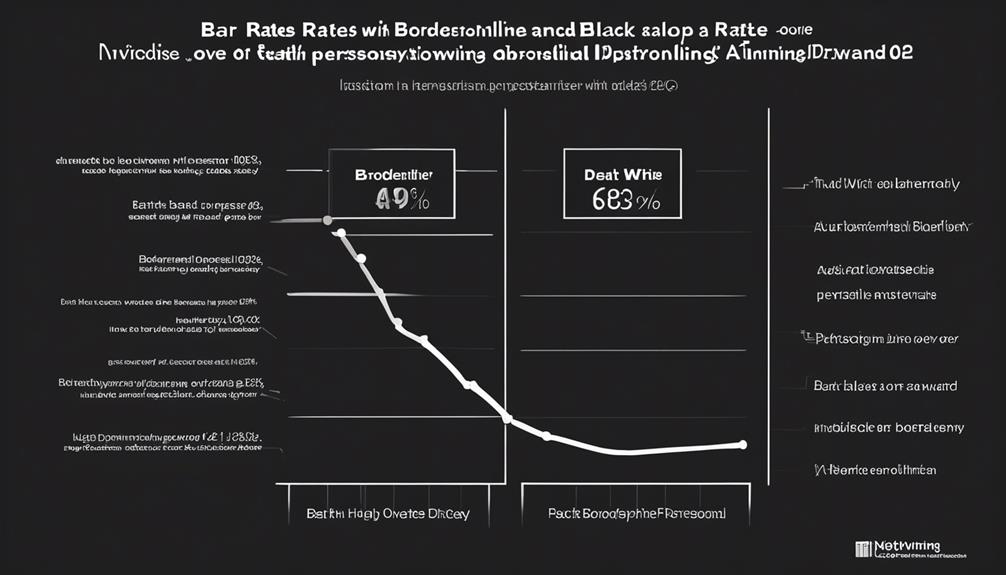Studying the mortality rate associated with BPD is akin to unraveling a complex puzzle; as each layer is uncovered, we acquire a deep understanding of the challenges endured by those with Borderline Personality Disorder.
The statistics paint a stark picture, hinting at a complex web of factors influencing mortality rates in this population.
As we uncover the factors contributing to these alarming numbers, a deeper understanding emerges, shedding light on the urgent need for targeted interventions and support systems.
Stay tuned to unravel the intricate dynamics between BPD, suicidality, and other critical components impacting life expectancy in this community.
Key Takeaways
- Up to 10% of BPD individuals die by suicide.
- Substance abuse worsens BPD symptoms and impacts life expectancy.
- Specialized psychotherapy like DBT can improve prognosis.
- Targeted interventions are vital for reducing BPD mortality rates.
Alarming Statistics on Bpd Mortality
When analyzing the alarming statistics on BPD mortality, it becomes evident that individuals diagnosed with Borderline Personality Disorder face a significantly higher risk of suicide compared to the general population. Research indicates that up to 10% of individuals diagnosed with BPD die by suicide, underscoring the severity of the condition. Furthermore, individuals with BPD have a mean of three lifetime suicide attempts, highlighting the chronic risk of suicidal behaviors associated with this disorder.
Factors contributing to the lower life expectancy of individuals with BPD include not only suicide but also substance abuse and engagement in high-risk activities. These high-risk behaviors, coupled with challenges in self-care practices and maintaining employment, significantly impact the overall health and mortality rates of individuals with BPD. Addressing these critical issues through targeted interventions and support systems is essential in reducing the mortality rate associated with Borderline Personality Disorder.
Factors Contributing to Bpd Death Rate

Factors contributing to the elevated death rate among individuals with Borderline Personality Disorder (BPD) include the prevalence of suicide as a leading cause of premature mortality in this population. Additional risk factors exacerbate this issue:
- Substance Abuse and Addiction: Individuals with BPD are more susceptible to substance abuse and addiction, which significantly increase the likelihood of premature death.
- Engagement in High-Risk Activities and Impulsive Behaviors: The impulsive nature of individuals with BPD often leads to engaging in high-risk behaviors, further elevating their risk of premature death.
- Unemployment and Lack of Physical Activity: Unemployment rates are higher among individuals with BPD, leading to decreased physical activity levels, which can contribute to premature mortality.
- Neglect of Self-Care Practices: Individuals with BPD may neglect self-care practices, such as regular medical check-ups and healthy lifestyle choices, which can impact their overall health and increase the likelihood of premature death.
Understanding these factors is crucial in developing targeted interventions to address the elevated death rate among individuals with BPD.
Impact of Suicidality in Bpd
The prevalence of suicide as a leading cause of premature mortality in individuals with Borderline Personality Disorder (BPD) underscores the significant impact of suicidality within this population. Up to 10% of individuals with BPD die by suicide, highlighting the severity of this issue. BPD patients, on average, have three lifetime suicide attempts, emphasizing the chronic risk of suicidal behavior associated with the disorder.
Non-Suicidal Self-Injury (NSSI) is common in BPD, often used for emotional regulation rather than with suicidal intent. Suicidal behaviors and self-harm in BPD patients are prevalent but don't always result in completed suicides, indicating a complex relationship between suicidality and mortality. While most individuals with BPD show improvement over time, the persistent risk of suicidal behaviors remains a critical concern in managing the disorder.
Understanding the interplay between suicidality, emotional dysregulation, and mortality is crucial for effective interventions and support for individuals with BPD.
Relationship Between Bpd and Substance Use

Substance use serves as a common coping mechanism for emotional distress among individuals diagnosed with Borderline Personality Disorder (BPD). This relationship between BPD and substance use has significant implications for the individuals affected.
Here are four key points to consider:
- Exacerbation of BPD symptoms: Substance abuse can worsen BPD symptoms, leading to increased emotional dysregulation and instability.
- Risk of addiction: Individuals with BPD engaging in substance use are at higher risk of developing addiction, creating a destructive cycle that's challenging to break.
- Physical health consequences: Substance use in BPD patients can lead to various physical health issues, further impacting their overall well-being.
- Impact on life expectancy: Addiction, higher-risk activities, and impulsive behaviors associated with substance use can negatively affect the life expectancy of individuals with BPD.
Understanding the complex interplay between BPD and substance use is crucial for developing effective interventions to improve outcomes and quality of life for these individuals.
Strategies for Improving Bpd Life Expectancy
In exploring avenues to enhance the life expectancy of individuals diagnosed with Borderline Personality Disorder (BPD), it's imperative to prioritize outpatient treatment strategies that have demonstrated efficacy in improving overall well-being and reducing self-harm behaviors. Engaging BPD patients in specialized psychotherapy, such as Dialectical Behavior Therapy (DBT), within ambulatory settings can significantly impact their prognosis. Avoiding frequent hospitalizations in favor of structured day treatment programs can prevent setbacks and offer intensive care while maintaining independence.
Psychotherapy modalities like mentalization-based therapy, transference-focused psychotherapy, and schema-focused therapy provide essential tools to address emotional dysregulation and interpersonal conflicts commonly seen in BPD. Although pharmacological interventions for BPD lack robust evidence, focusing on outpatient psychotherapy remains paramount for enhancing life expectancy and functional outcomes in individuals with this disorder. By emphasizing outpatient care and evidence-based therapies, we can strive to improve the long-term prognosis for individuals battling Borderline Personality Disorder.
Frequently Asked Questions
What Is the Mortality Rate of Bpd?
Individuals with Borderline Personality Disorder (BPD) face a significantly higher risk of suicide compared to the general population. Suicide is a leading cause of premature death in this group, with up to 10% of BPD individuals dying by suicide. They've a mean of three lifetime suicide attempts, underlining the persistent vulnerability to suicidal behaviors.
Targeted interventions for high-risk patients are crucial in preventing such tragedies.
What Is the Life of Someone With Bpd?
Living with Borderline Personality Disorder (BPD) poses unique challenges. Individuals with BPD often experience intense emotional turmoil, leading to difficulties in regulating emotions and relationships. Symptoms can vary but commonly include unstable self-image, impulsive behavior, and fear of abandonment.
Therapy, medication, and support can aid in managing BPD, improving overall quality of life. Developing coping strategies, self-awareness, and healthy boundaries are crucial for individuals with BPD.
What Are the Chances of Surviving Bpd?
Surviving BPD is challenging but possible with effective treatment and support. By addressing underlying issues, learning coping skills, and engaging in therapy, individuals with BPD can improve their quality of life and reduce the risk of negative outcomes.
It's essential to seek help from mental health professionals, build a strong support network, and commit to ongoing self-care practices to increase the chances of managing BPD successfully.
Does BPD Worsen With Age?
As we age, symptoms of Borderline Personality Disorder (BPD) can vary. While some individuals may experience a decrease in impulsivity and emotional dysregulation, others might find their symptoms persist. Factors like improved coping skills and emotional stability can contribute to symptom management.
Therapy and treatment interventions play a crucial role in helping individuals navigate BPD symptoms effectively as they get older. Management strategies can lead to improved quality of life for many individuals with BPD.
Conclusion
In conclusion, the statistics on BPD mortality are alarming, with a significantly elevated risk of premature death, particularly due to suicide.
The relationship between BPD and substance use further complicates the issue.
To improve BPD life expectancy, targeted strategies for suicide risk assessment and prevention are crucial.
Let's navigate through this complex landscape like skilled sailors, steering towards a horizon of hope and resilience.









